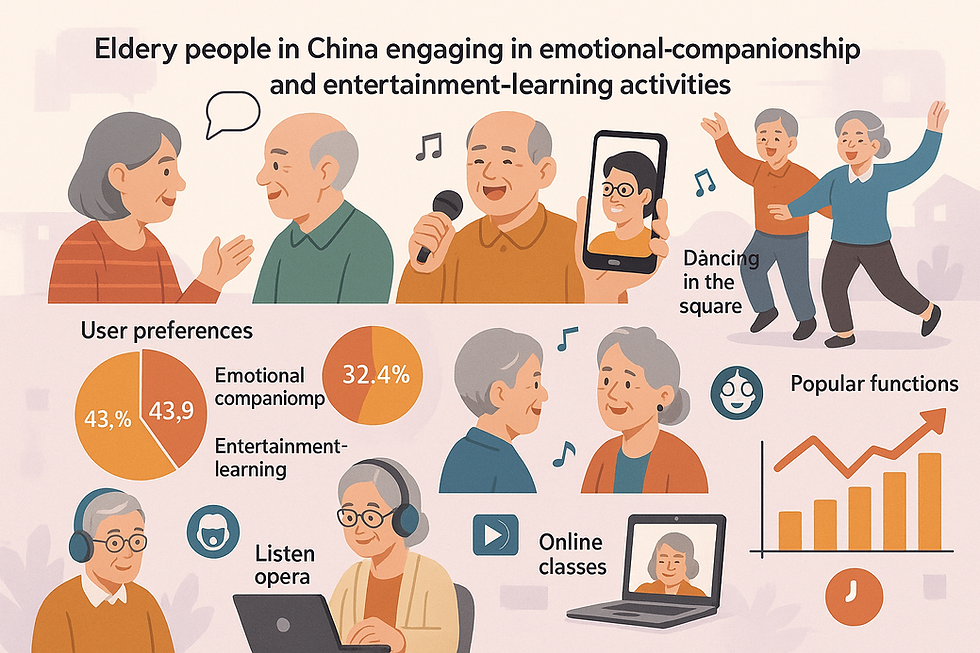Market Opportunities for Embodied Intelligent Robotics in Medical Rehabilitation and Home Companionship
- NXLongevity

- Jul 8
- 4 min read

Report Date: July, 2025
Purpose: To provide companies in the embodied intelligent robotics industry with a holistic market commercialization analysis, guiding strategy formulation in medical rehabilitation and home companionship sectors.
Executive Summary
Embodied intelligent robotics, the fusion of artificial intelligence and robotics, is poised to transform the medical rehabilitation and home companionship markets. The global medical rehabilitation robotics market is projected to grow from $428 million in 2024 to $1.05 billion by 2030, with a compound annual growth rate (CAGR) of 15.2%. Meanwhile, the home companionship robotics market is expected to expand from $2.091 billion in 2024 to $5.483 billion by 2030, with a CAGR of 17.6%. These trends are driven by aging populations, technological advancements, and supportive government policies.
This report analyzes market conditions, competitive landscapes, opportunities, challenges, and provides actionable strategies to help industry players capitalize on these growing sectors. Key recommendations include targeting niche markets, initiating pilot projects, fostering partnerships, and leveraging policy incentives to accelerate commercialization.
1. Market Overview
1.1 Medical Rehabilitation Robotics Market
Market Size and Growth:
2024: $428 million; 2030: $1.05 billion; CAGR: 15.2% (Source: Grand View Research).
Drivers:
Aging populations increasing demand for rehabilitation due to strokes and spinal injuries.
Rising healthcare spending and adoption of advanced rehabilitation technologies.
Integration of AI and multimodal large-scale models enhancing adaptability and efficacy.
Key Applications:
Exoskeleton Robots: e.g., HAL (Hybrid Assistive Limb) and Ekso Bionics for lower limb paralysis.
Arm Rehabilitation Robots: e.g., ARMin III for stroke patients’ upper limb recovery.
Gait Training Systems: e.g., Lokomat by Hocoma for lower limb rehabilitation.
Challenges:
High costs limit adoption in outpatient and home settings.
Limited long-term clinical data validating efficacy.
1.2 Home Companionship Robotics Market
Market Size and Growth:
2024: $2.091 billion; 2030: $5.483 billion; CAGR: 17.6% (Source: Grand View Research).
Drivers:
Aging populations driving demand for elderly care solutions.
Growing markets for children’s education and entertainment.
Advances in AI and robotics enabling more natural human-robot interactions.
Key Applications:
Children’s Educational Robots: e.g., Miko AI-Powered Robot for learning and play.
Elderly Companionship Robots: e.g., Blue Frog Robotics Buddy for emotional support.
Smart Pet Robots: e.g., Loona Smart Petbot for entertainment.
Challenges:
Limited functionality for fully autonomous household tasks.
High costs may hinder penetration in middle- and low-income households.
2. Commercialization Opportunities
2.1 Medical Rehabilitation Sector
Target Niches:
High-end rehabilitation devices like exoskeletons and gait training systems.
Customized solutions for diverse patient needs.
Partnership Strategies:
Collaborate with hospitals and rehab centers for clinical trials and validation.
Partner with medical device manufacturers for integrated solutions.
Policy Leverage:
Tap into government AI and robotics incentives for funding and resources.
2.2 Home Companionship Sector
Target Niches:
Elderly-focused robots offering emotional and daily living support.
Educational and entertainment robots for children.
Differentiation:
Leverage embodied intelligence for emotionally responsive, natural interactions.
Offer modular designs to meet varied user preferences.
Ecosystem Collaboration:
Integrate with smart home systems through partnerships with tech firms.
Work with educational institutions to promote children’s robots.
3. Competitive Landscape
3.1 Medical Rehabilitation Sector
Key Players:
Stryker Corporation: Global medical tech leader with 2023 sales exceeding $20 billion.
Hocoma (Lokomat): Dominant in gait training systems.
CYBERDYNE (HAL): Leader in exoskeleton robotics.
Competitive Strengths:
Established product portfolios and market presence.
Strong clinical validation and regulatory approvals.
3.2 Home Companionship Sector
Key Players:
Miko AI-Powered Robot: Leader in children’s education robots.
Blue Frog Robotics Buddy: Top player in elderly companionship.
UBTech Robotics: Developing advanced humanoid companions.
Competitive Strengths:
Brand recognition and user experience expertise.
Advanced emotional interaction technologies.
4. Commercialization Strategies
4.1 Product Development
Medical Rehabilitation: Focus on precision exoskeletons and gait systems with personalized rehab plans.
Home Companionship: Create emotionally intelligent robots for elderly and children’s markets.
4.2 Market Entry
Pilot Programs: Launch trials in key markets (e.g., China, EU) to gather feedback and data.
Pricing Models: Offer leasing or installment plans to reduce upfront costs.
4.3 Marketing and Education
Branding: Highlight technical advantages and real-world benefits via media and industry events.
User Education: Use whitepapers, case studies, and demos to showcase value.
4.4 Partnerships and Ecosystems
Industry Alliances: Partner with healthcare providers, rehab centers, and schools.
Tech Collaboration: Work with AI firms to enhance robot intelligence.
4.5 Policy and Funding
Government Support: Secure industry grants to boost R&D and market entry.
Global Expansion: Target EU and North America for technical and financial advantages.
5. Conclusion
The embodied intelligent robotics industry holds immense potential in medical rehabilitation and home companionship. Companies should prioritize niche markets, pilot projects, partnerships, and policy support to drive commercialization. With innovation and strategic planning, firms can secure a competitive edge in these high-growth markets.
Appendix: Market Size and Competitor Comparison
Sector | 2024 Market Size | 2030 Projected Size | Key Competitors | Success Stories |
Medical Rehabilitation | $428 million | $1.05 billion | Stryker, Hocoma, CYBERDYNE | HAL, Lokomat |
Home Companionship | $2.091 billion | $5.483 billion | Miko, Blue Frog, UBTech | Miko, Buddy, Loona Petbot |
This report equips embodied intelligent robotics companies with a detailed commercialization roadmap to succeed in these dynamic markets.




Comentarios